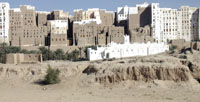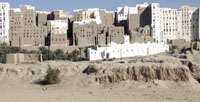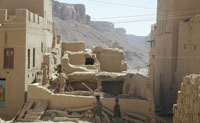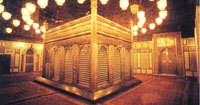
Restoring Shibam, saving an architectural wonder [Archives:2007/1074/Last Page]
August 6 2007
 |
 |
For Yemen Times
Shibam, located in the Yemeni province of Hadramout, is known as the “Manhattan of the desert.” Its ancient center, which at present still comprises 400 inhabitable clay towers, is unique in the world and was declared a World Cultural Heritage site by UNESCO in 1982. Situated in a fascinating age-old cultural landscape, the city had been a junction of caravan trade routes. But in the course of the 20th century, Shibam lost its historic economic base, and most of its population slid into poverty.
An urban development plan aimed at Shibam's preservation and economic self-sufficiency and based on the potential and skills of its inhabitants and local government is intended to benefit the population and avert the threatened decline of the old city.
An agreement for carrying out an infrastructural development project of the historical city was signed recently in Mukalla. The project has a gross cost of $500,000 to be funded by the Social Fund for Development, GTZ (Deutsche Gesellschaft fur technische Zusammenarbeit) and Hadramout governorate authorities.
The experimental section of the rehabilitation project of Shibam would import necessary materials for water, electricity and telephone networks. The infrastructural project aims at rehabilitation of the city's full services at a cost of $4 million.
The project follows the guiding principle that Old Shibam can be preserved only if the population commit themselves to their city and consider it worth living in. Hence the objective is to create more attractive living and working conditions, and to achieve better urban management, taking into account the value of the city as a UNESCO World Cultural Heritage site.
Why Shibam?
Shibam is one of the most important cities in Hadramout valley, dating back to the third century B.C. The city is situated in the middle of Hadramout valley on a hill 30 meters above the valley level, located 19 kilometers from Si'oun on a paved road leading to Mukalla. Shibam has been mentioned in many referenced inscriptions. The houses form a firmly built castle, rise 8 stories high and are built of clay “bricks.” Many European travelers, after visiting Shibam, labeled it “Manhattan of the desert” and “skyscraper city.” It is considered one of the most beautiful historic Yemeni cities after ancient Sana'a.
UNESCO announced an international campaign to protect Shibam in 1984. It is considered an architectural rarity which cannot be repeated, its location a gem in the middle of Hadramout valley, perched on a high hill, appearing to the observer as a castle in an ancient valley. The city's unique history and architecture make it one of the most popular tourist destinations in Yemen. Many people believe that it should be declared among the top wonders of the world.
Being a city in Hadramout governorate is another distinguishing characteristic, as Hadramout is comprised of different topography. Included amongst this topography are coastal plains containing beautiful shores along the Arabian Sea, mountains and hills of heights reaching 2000 meters above sea level, large desert areas of Al-Ruba Al-Khali and numerous valleys, including the largest and most fertile valley in the Arab peninsula, spanning 160 kilometers and pouring into Sihout on the Arab sea in Al-Mohra governorate.
The hot tropical climate in Hadramout reaches 40 degrees Celsius during summer months in interior areas. Coastal area temperatures reach 36 degrees Celsius due to seasonal winds saturated with moisture. Winter temperatures tend to be moderate in the coastal areas at 20-24 degrees Celsius with interior areas reaching 17-20 degrees Celsius.
Hadramout governorate has been presented in history books as the land of Ahqaf. Historians reported that Amir Bin Qahtan was the first to land in Ahqaf after “A'ad” and if he went to war, he killed much. When he went to battle he would leave the message, “Death has come.” This became his title and the area was named accordingly where “Hadra” means came and “mout” means death.
Hadramout has a deep-rooted past distinguished with continuity throughout the different historic phases until present. Archeological research done in Hadramout valley indicated that the southern peninsula witnessed human activity in the first stone ages and was home to one of the oldest Yemeni kingdoms, Hadramout kingdom, which flourished at the start of the first millennium B.C. Many ancient cities flourished in this area and experienced advancements in art and architecture, as well as development in irrigation and political systems.
Hadramout is considered one of the main roots of Yemeni civilization, rich with historic antiquities, particularly the region's architecture, represented by its ancient yet well-preserved skyscrapers. The remains indicate monumental ruins of cities, temples and prophet's graves, including Prophet Hud and Saleh, peace be upon them.
Efforts at Revitalization
GTZ supports the cultural, economic and social initiatives of the local government and citizens of Shibam to restore the historic trading center. Culturally sensitive restoration of the ancient clay towers will preserve the famous cityscape, simultaneously improving living conditions. Financial subsidies amounting to 35 percent of the renovation costs, as well as technical advisory services, will enable local residents to implement rehabilitation proposals.
Traditionally, girls in Yemen marry early and cut their school education short. To enable women to continue their education and contribute to the family income, courses in handicrafts, computing and literacy will be offered in collaboration with non-governmental organizations. Additionally, abandoned gardens will be restored, affording farm families an important income source.
To further improve the quality of life in Shibam, renovation of the water and sewage system is planned.
Since the project began, the social and economic situation, and thus the quality of life for the people in Shibam, has markedly improved. Nearly a third of all house owners have been informed about possible renovations; about 100 owners have already renovated their buildings, raising substantial funds of their own for this purpose. House owners are now being advised by young architects who are familiar with traditional ways of building and can also work with modern techniques.
An important concern of local inhabitants was a functioning waste disposal system, which today is being provided by the local government, mostly on its own, for all settlements in the Shibam district.
In order to enhance incomes and strengthen Shibam citizens' sense of responsibility for their city, three registered associations have been set up. They actively promote youth and women initiatives as well as cultural tourism. Additionally, they aim to revive farming in the region.
——
[archive-e:1074-v:15-y:2007-d:2007-08-06-p:lastpage]


